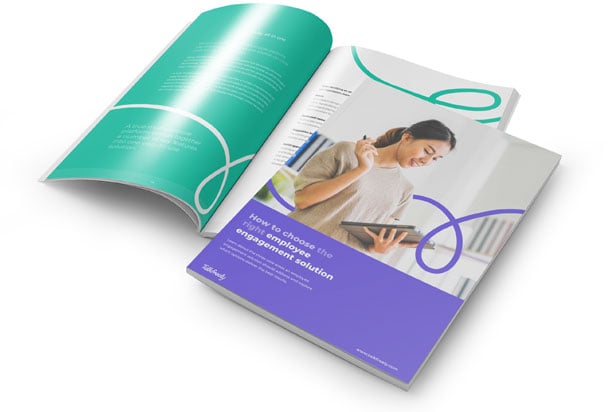There’s a new phrase on the block: hybrid working. Along with many of the new terms generated by the pandemic, this one is having a dramatic impact on our working lives. Now, a few days working from home has become the norm rather than an anomaly. People no longer expect to be office-bound for five days a week. And so, our methods of communication need to adapt as a result.
Throughout the pandemic, companies focused on adapting to the sudden switch to home working. There has been a lot of HR attention given to transferring employees from offices to home, with efforts concentrated on keeping them happy and productive. But now, we need to adapt our approach for hybrid workers.
What employee engagement ideas need to be deployed to counteract the additional complexities for those who follow a flexible office and remote working pattern?
The fact is that increased isolation was a challenge to employee engagement for remote workers before the pandemic hit. Millions of people work in the community, or private homes (for example, social and domestic care workers, engineers and tradespeople) and many organisations manage multi-site operations, from retailers to charities. The pandemic, however, has made people look for increased connections and sources of certainty. Employers can take this opportunity to figure out how to improve employee engagement and become a symbol of trust to their employees.
According to the Office for National Statistics, the proportion of hybrid workers has risen from 13% in early February 2022 to 24% in May 2022. Hybrid working is here to stay. In this blog, we look at the three main factors that have significantly improved employee engagement for hybrid workers.
How to improve employee engagement: 3 steps to success
These three focus points will help you fully engage with your workers, whether they’re office-based, on the road or working from home. Employing these initiatives to improve employee engagement will help your workers reconnect with their colleagues and boost productivity across the board.
Step 1: Focus on Safety
Improve employee engagement by addressing health and safety concerns on a regular basis
Unsurprisingly, safety has become the number one topic of concern for employers and employees. Anxiety levels spiked during the first lockdown, and while most of us have relaxed a little as the pandemic recedes, mental health is still a key concern. The Office for National Statistics reported that 69% of adults felt very or somewhat concerned about the effects of the pandemic on their lives. These mental health problems can potentially create significant downturns in employee engagement and motivation.
Addressing these health and safety concerns can go a long way to reducing anxiety levels.
Employers can find ways to challenge the barriers to employee engagement during difficult times. Publishing a comprehensive well-being and safety plan will help employees feel less isolated or give them confidence when dealing with customers.
By using baseline values of honesty and trust, employers can find the positives among the challenges by emphasising the strengths of their people. Combine that with increased visibility (even virtual) of the company’s leaders, and engagement can flourish from optimism, clarity and trust. A study by Perceptyx showed that when employees are satisfied with communications about the company’s response to coronavirus, 96% believe that their employer puts their safety first. However, when communication is poor, only 30% think so. These employee engagement statistics reveal that employee perception is all-important.
When looking for ways to improve employee engagement, you need to start with the relationship between employee and employer. The foundation of the employee engagement model is the health of the psychological contract between employer and employee. And change generally affects this contract profoundly.
Covid 19 has forced businesses to make huge changes, so a thorough but flexible communications strategy is needed to explain what is happening and, more importantly, why it is happening. This will reduce the risk of conflict around such potentially contentious matters as workplace surveillance and tracking employee movements. Hybrid working is a challenge to navigate successfully. When a company’s workforce is split between home workers, office workers and those working between premises, employees must understand that keeping track of them is part of a company’s duty to keep them safe. Of all the ideas to improve employee engagement, staff safety should always come first.
If a workforce is separated or even feeling disconnected, instilling a sense of safety is a key part of how to improve employee engagement. It is down to the company to identify any required changes to the drivers of employee engagement in this new working environment.
Action Point: Show employees that you care
Send out regular, scheduled communications addressing health and safety concerns. An employee app will help you schedule messages and connect with hybrid workers, ensuring they’re not left out of the loop.
Step 2. Focus on Culture
Extending the company culture beyond head office goes a long way towards improving employee engagement
A company’s culture doesn’t sit within its offices or factories but within its leaders and people. Businesses are learning that they need to maintain their efforts to keep their staff engaged, but they may need to do things differently. If venues can organise virtual comedy nights, organisations can use a good employee engagement platform to manage recognition, celebration and even social events at a distance. Hybrid working doesn’t have to mean the end of socialising.
There is little doubt that the disruption caused by hybrid working patterns makes improving employee engagement more challenging. However, adopting a relevant employee engagement strategy should help maintain motivation and performance, creating a resilient office culture. Unfortunately, some aspects of employee engagement initiatives fall by the wayside during economic uncertainty. Strong companies, though, will try to maintain their core commitments. Some ‘how to improve employee engagement’ tips include:
Action Point: Implement staff development opportunities
Professional online learning flourished during the lockdown, offering new avenues to companies. A revised learning and development plan, including remote education, could be an important way to improve employee engagement.
Action Point: Encourage continuous improvement
Periods of uncertainty and change can be fertile ground for radical ideas from employees, so it is important to continue encouraging suggestions and feedback via an employee engagement survey. This could include a section on how to improve employee engagement ideas to ensure that the company’s thinking is aligned with its employees’ needs.
Action Point: Offer strategy updates
It’s important to remember that hybrid workers may feel disconnected from the usual office communication flow. Regular messaging on how the business is still striving to reach its goals will reassure employees that they work for a successful company and improve staff engagement. An employee engagement app will provide a helpful newsfeed for company updates.
Step 3. Focus on Leadership
How to improve employee engagement? Make sure your leaders are active and visible
Company values must be maintained and, indeed, given even higher prominence to improve employee engagement. According to the Chartered Management Institute, emphasising the company’s values to employees is essential to leading the workforce through tough times and new working arrangements.
Values are demonstrated by everyone in a company, but the leaders are the role models. Senior managers must engage in rational thinking, particularly in times of change. For hybrid workers, communication from the senior leadership team is vital. A channel such as an employee engagement app can help communicate the company’s values and establish how important they are in supporting everyone to stay safe and well.
In essence, leaders have to act like governments by assessing the available scientific and medical advice and deciding how best to implement a strategy to protect the business, its employees and its customers. It’s crucial to have clear messaging around that strategy, including steps on ways to improve employee engagement.
However, it’s equally important to recognise that plans will have to change as the business landscape adapts to the new normal. Having flexible and responsive communications channels with employees means that companies can update staff, encourage employee voice and increase employee engagement.
Highlighting the company’s values during that messaging will, in turn, make employees feel valued, which is an important component when deciding how to improve employee engagement. This means that all workers, no matter where they are or what they are doing, will work towards the same goal and be included.
Action Point: Keep your leaders front of mind
When your hybrid workers are working remotely, they are much more likely to feel a disconnect from head office and the management team. Ensure your leaders remain front of mind with regular communications, video messages and updates. An employee app will keep your hybrid workers feeling connected by giving them that vital link to the office, wherever they may be.









